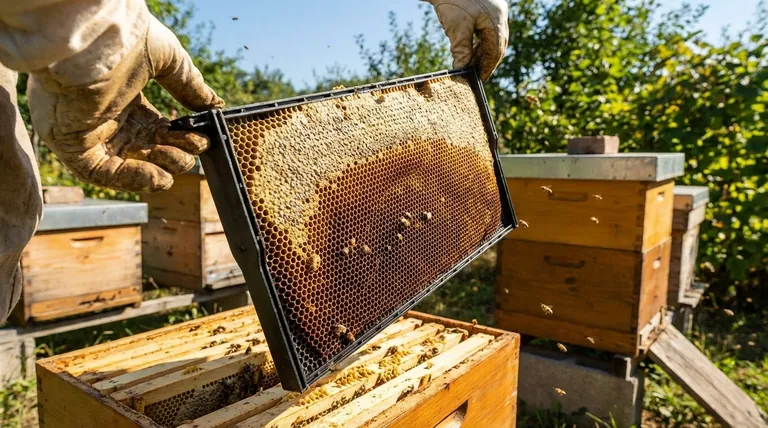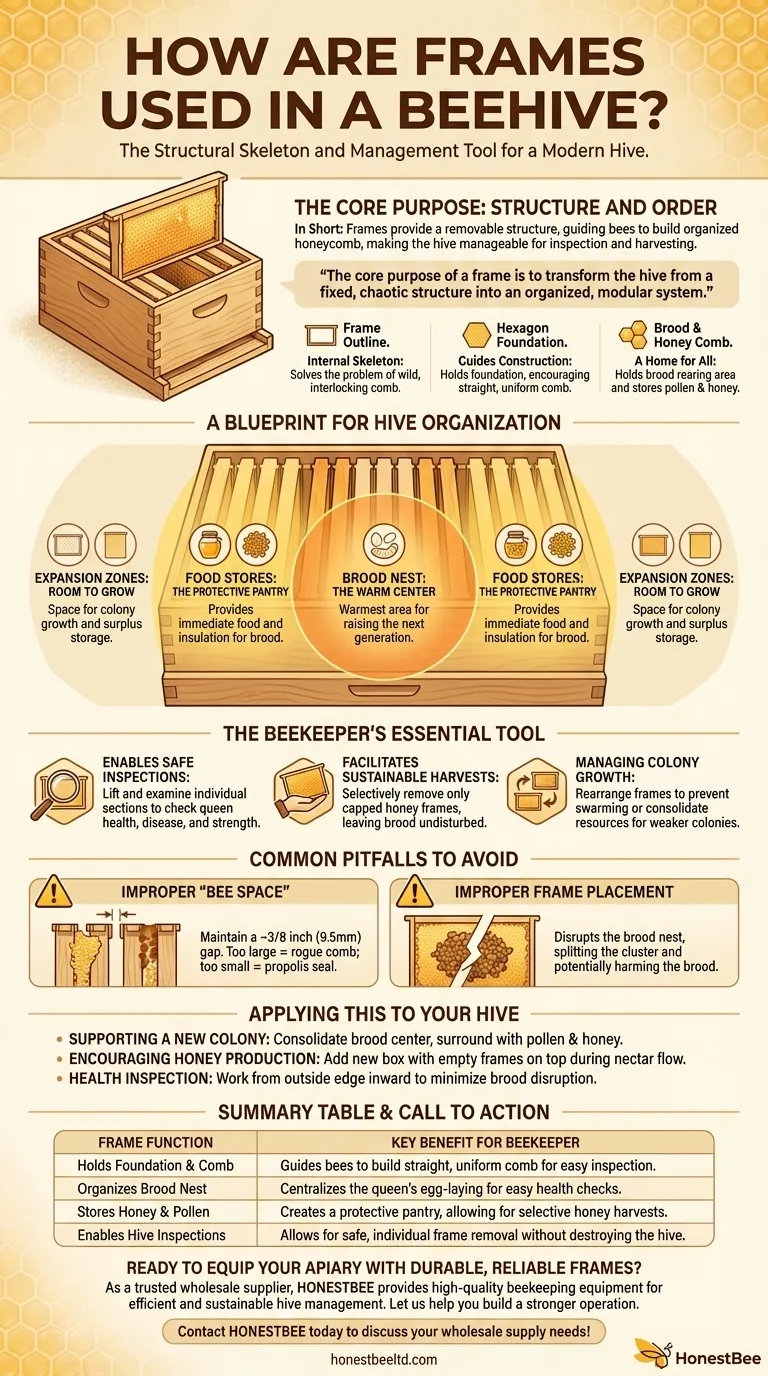In short, beehive frames provide a removable structure that guides bees to build their honeycomb in an organized manner. These frames hold the comb where the queen lays her eggs and where the colony stores honey and pollen, making the hive manageable for inspection and honey harvesting without causing chaos or destruction.
The core purpose of a frame is to transform the hive from a fixed, chaotic structure into an organized, modular system. This allows the beekeeper to act as a steward, managing the colony's health and resources with minimal disruption to the bees.

The Core Purpose: Structure and Order
Frames are the internal skeleton of the modern beehive. They solve the fundamental problem of how to access a bee colony, which would otherwise build its comb in a fixed, interlocking mass.
From Wild Comb to an Organized System
In nature, bees build comb wherever they see fit, often attaching it to multiple surfaces. This creates a strong but immovable structure. Frames force the bees to build their comb within a single, self-contained wooden or plastic rectangle.
This simple constraint is revolutionary. It ensures each section of comb can be removed and inspected individually.
Holding the Foundation and Comb
Most frames are designed to hold a sheet of foundation, which is a thin sheet of beeswax or plastic imprinted with the hexagonal pattern of honeycomb cells. This foundation acts as a guide, encouraging bees to build straight, uniform comb.
The bees then "draw out" the comb, building up the cell walls to create the familiar honeycomb structure. The frame provides the essential support for this delicate wax construction.
A Home for Brood and Food
The finished comb held within a frame serves two critical functions for the colony. It is used for brood rearing, where the queen lays her eggs and the young bees develop, and for the storage of food—both pollen (protein) and honey (carbohydrates).
A Blueprint for Hive Organization
The placement of frames within a hive box is not random; it follows the bees' natural instincts. This arrangement is crucial for the colony's efficiency and survival.
The Brood Nest: The Warm Center
Frames containing brood—eggs, larvae, and pupae—are almost always placed in the center of the lowest hive box. This central area is the warmest part of the cluster, providing the ideal temperature for raising the next generation of bees.
Food Stores: The Protective Pantry
Frames containing honey and pollen are placed on either side of the brood nest. This creates a "pantry" that surrounds the nursery, providing immediate access to food for the nurse bees feeding the young. These food frames also serve as a layer of insulation, helping to protect the brood from cold.
Expansion Zones: Room to Grow
Empty frames, or frames with foundation that has not yet been drawn out, are typically placed at the outermost edges of the box. As the colony expands, the bees will build new comb on these frames, creating more space for food storage or for the queen to lay.
The Beekeeper's Essential Tool
For the beekeeper, frames are the primary tool for interacting with the colony. They make hive management possible.
Enabling Safe Inspections
Frames allow a beekeeper to lift out and examine individual sections of the hive. This is essential for checking the queen's health, looking for signs of disease or pests, and assessing the colony's overall strength and food reserves.
Facilitating Sustainable Harvests
When it is time to harvest honey, the beekeeper can selectively remove only the frames that are filled exclusively with capped honey. The frames containing brood are left undisturbed, ensuring the colony's survival and continuity.
Managing Colony Growth
Beekeepers can actively manage the colony by rearranging frames. They might add empty frames to give a booming population more space, preventing a swarm, or consolidate a weak colony's resources onto fewer frames to help them conserve heat.
Common Pitfalls to Avoid
While frames are a simple concept, their effective use requires an understanding of bee behavior.
The Importance of "Bee Space"
Hives and frames are designed to maintain a specific gap—known as bee space—of about 3/8 of an inch (9.5mm) between components. If the gap is too large, bees will fill it with rogue comb; if it's too small, they will seal it with propolis, gluing the frames together.
Improper Frame Placement
Placing an empty frame in the middle of the brood nest can be disruptive. This can split the cluster, making it harder for the bees to regulate temperature and potentially harming the brood. New frames should generally be added to the edges or in a new box on top.
Applying This to Your Hive
Your strategy for frame management will depend on your immediate goal for the colony.
- If your primary focus is supporting a new colony: Ensure brood frames are consolidated in the center with adjacent frames of pollen and honey to give them a strong, resource-rich start.
- If your primary focus is encouraging honey production: During a nectar flow, add a new box of empty frames on top of the brood boxes to give bees dedicated space to store surplus honey.
- If your primary focus is a health inspection: Start from an outside frame and work your way inward, carefully returning each frame to its original position to cause minimal disruption to the brood nest.
Ultimately, understanding how to use and arrange frames is the foundation of responsible and effective beekeeping.
Summary Table:
| Frame Function | Key Benefit for Beekeeper |
|---|---|
| Holds Foundation & Comb | Guides bees to build straight, uniform comb for easy inspection. |
| Organizes Brood Nest | Centralizes the queen's egg-laying for easy health checks. |
| Stores Honey & Pollen | Creates a protective pantry, allowing for selective honey harvests. |
| Enables Hive Inspections | Allows for safe, individual frame removal without destroying the hive. |
Ready to equip your apiary with durable, reliable frames? As a trusted wholesale supplier to commercial apiaries and distributors, HONESTBEE provides the high-quality beekeeping equipment you need to manage your hives efficiently and sustainably. Let us help you build a stronger, more productive operation. Contact HONESTBEE today to discuss your wholesale supply needs!
Visual Guide

Related Products
- Plastic Bee Frame Beekeeping Hive Frames for Wholesale
- 7 x Auto Bee Flow Hive Frames Plastic Beekeeping Hive Box Supplies
- Assembled Wooden Bee Frames with Beeswax Foundation Ready to Use by HONESTBEE
- Assembled Wooden Bee Frames with Plastic Foundation for Durability and Convenience by HONESTBEE
- HONESTBEE Wired and Assembled Wooden Bee Frames Foundation for a Thriving Hive
People Also Ask
- Are plastic frames good? Boost Apiary Efficiency with Durable, Pest-Resistant Frames
- Can beekeepers switch between wooden and plastic frames? Optimize Your Hive's Performance
- What are the differences between wooden and plastic frames in beehives? Choose the Best for Your Apiary
- Are plastic bee hive frames good? A Guide to Modern Durability vs. Natural Appeal
- What is a general rule for beekeepers with many hives regarding frame choice? Maximize Efficiency with Plastic Frames



















